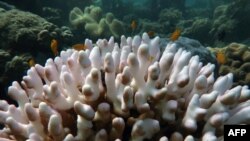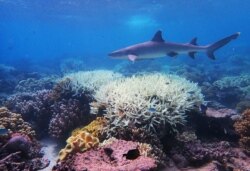The Great Barrier Reef off the coast of Australia is suffering its third mass bleaching event in five years, but the current global health pandemic has pushed the news of the major environmental crisis onto the back burner.
New scientific data, confirmed by Australia's Great Barrier Reef Marine Park Authority, shows ample evidence that overheating of the ocean is causing new damage along the world's largest coral reef system.
The barrier reef takes up an area of about 344,000 square kilometers in the Coral Sea, off the coast of Queensland, Australia. A third of the corals in the reef perished after the 2016 heat wave. Another heat wave hit in 2017.
Coral live in a symbiotic unity with algae, which convert sunlight into food for the coral polyps and give the corals their distinctive color. The brightly colored coral islands, or atolls, are visible from an airplane.
When the water temperature rises by as little as 1 degree Celsius, the corals expel the algae and begin to starve. They survive for some time, but they lose color and become fragile and susceptible to disease.
The world's oceans absorb most of the heat resulting from carbon emissions produced by humans, and the oceans are warming faster than expected. The year 2019 was the hottest on record for the world's oceans. February, which is summertime in Australia, was the warmest month on record for water temperatures near the reef.
The Great Barrier Reef has had five major bleaching episodes since 1998, but the first few were further apart.
Jodie Rummer, marine biologist from James Cook University in Australia, was part of an international team of scientists who tracked wild populations of five species of coral reef fish before, during and after the 2016 heat wave. She said the team was surprised to find that water temperatures in February four years ago were much higher than expected.
"We were collecting fish in the shallow lagoon off the research station, and our dive computers read that the water temperature was 33°C," she wrote in The Conversation US online academic journal. "We looked at each other. These are the temperatures we use to simulate climate change in our laboratory studies for the year 2050 or 2100."
Scientists say the latest data show that this year's bleaching is second only to the 2016 episode. However, it was more widespread and affected the southern end of the reef, which was spared before. There are concerns that the rising water temperatures around the reef will make bleaching an annual occurrence.
In the past 20 years, much has been written about the destruction of the Great Barrier Reef and its consequences for marine life and for humanity. Environmentalists are becoming frustrated with what they see as a lack of action to prevent coral bleaching from recurring. With authorities worldwide engaged in battling the coronavirus pandemic, there is growing fear that coral reef disease may not get the attention it needs, especially among people who live far away from it.
On the northern shores of the Adriatic Sea, Croatian fishermen hold on to an old adage: "If you stick your finger into the sea, you are connected with the whole world."
Scientists warn that the coral decay is a bad omen for fish and other marine creatures that are an indispensable part of the food chain. They say many species won't have time to adapt to the accelerating rise of water temperatures.








